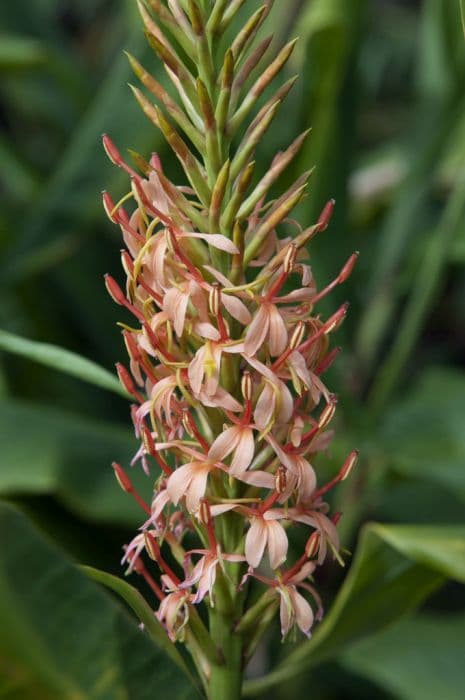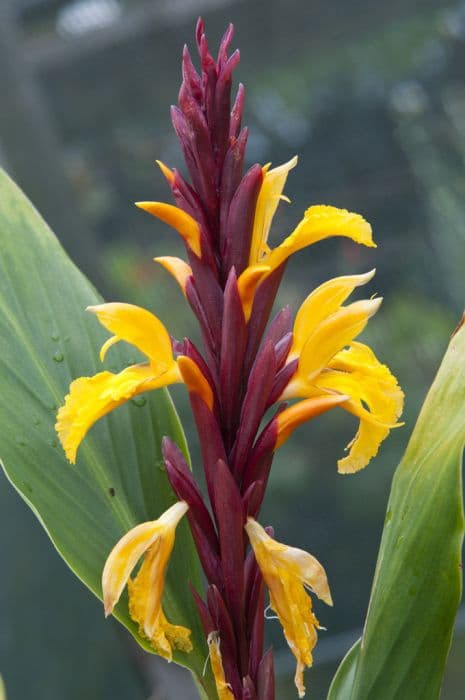Variegated Ginger Alpinia vittata (v)

ABOUT
Alpinia vittata, commonly known as the Variegated Shell Ginger, is a visually striking plant known for its broad, elongated leaves with distinctive variegation patterns. The leaves of Variegated Shell Ginger are a lush green, with irregular strips of creamy white or yellowish color running along their length, giving them a vibrant appearance that stands out in any garden setting. The foliage arises from a central stem, draping gracefully and creating a tropical feel. When in bloom, the plant produces flowers that have a shell-like shape, hence the name "Shell Ginger." The blooms are typically white, with a delicate, soft texture, and they often appear in clusters that droop elegantly from the stems. The overall appearance of Variegated Shell Ginger is that of a lush and decorative plant, with a dramatic foliage pattern that can provide a focal point in a garden or indoor space. Its leaves and blooms contribute to its exotic look, making it a popular choice for adding a touch of the tropics to various landscapes and interiors. Despite its showy nature, the actual size of the Variegated Shell Ginger may vary, but its impact on visual interest is invariably significant wherever it is grown.
About this plant
 Names
NamesSynonyms
Variegated Ginger, Painted Shell Ginger.
Common names
Maranta vittata, Phrynium vittatum.
 Toxicity
ToxicityTo humans
The Alpinia vittata, commonly known as the Variegated Ginger, is not typically known for being toxic to humans. There is no significant evidence to suggest that touching or ingesting this plant causes any serious harm to humans. However, it is always a good practice to avoid ingesting plants that are not commonly known as food, as individual allergic reactions or gastrointestinal discomfort may occur.
To pets
Regarding pets, the Alpinia vittata, or Variegated Ginger, is not listed among the commonly known toxic plants. Therefore, it is not expected to be toxic to pets such as dogs and cats. As with any non-food plant, ingestion of large amounts could potentially cause mild stomach upset, but there is no widely recognized record of serious poisoning from this plant in pets. It's always prudent to monitor pets and prevent them from consuming non-food plants, as individual animals might have sensitivities or allergic reactions.
 Characteristics
CharacteristicsLife cycle
Perennials
Foliage type
Evergreen
Color of leaves
Variegated
Height
2-3 feet (0.6-0.9 meters)
Spread
2-3 feet (0.6-0.9 meters)
Plant type
Herb
Hardiness zones
10
Native area
Southeast Asia
Benefits
 General Benefits
General Benefits- Aesthetic Appeal - The striking variegated leaves of Alpinia vittata, commonly known as Variegated Ginger, add visual interest and tropical flair to any garden or indoor space.
- Low Maintenance - Variegated Ginger is known for being relatively easy to care for, requiring minimal maintenance once established.
- Drought Tolerance - Once established, it can tolerate short periods of drought, making it suitable for regions with water scarcity.
- Shade Tolerance - It can grow in partial shade, providing flexibility in landscaping and garden design in areas with varied light conditions.
- Soil Adaptability - Alpinia vittata can adapt to a range of soil types, although it prefers well-draining soil, making it versatile for different garden settings.
- Container Gardening - It can be grown in pots, which makes it a good choice for balconies, patios, or indoors.
- Wildlife Attraction - The flowers of the Variegated Ginger can attract pollinators like bees and butterflies, promoting biodiversity.
 Medical Properties
Medical PropertiesThis plant is not used for medical purposes.
 Air-purifying Qualities
Air-purifying QualitiesThis plant is not specifically known for air purifying qualities.
 Other Uses
Other Uses- Alpinia vittata, commonly known as variegated ginger, lends itself as a natural fabric dye, with the leaves used to produce varying shades of green.
- The sturdy leaves of the variegated ginger can be formed into eco-friendly plates and serving dishes for outdoor events.
- Culinary enthusiasts sometimes use the large leaves as a flavor-infusing wrap for steaming food, adding a subtle, tangy aroma.
- Gardeners value variegated ginger as a companion plant due to its bright foliage that can help highlight the colors of nearby flowers.
- Variegated ginger's dense growth habit makes it an effective privacy screen or garden border when planted en masse.
- In floral arrangements, the striking leaves of variegated ginger add an exotic touch to bouquets and centerpieces.
- Extracts from the leaves can be used as a natural insect repellent when applied to the skin or used in outdoor sprays.
- Variegated ginger is sometimes planted in large containers to create movable garden accents that can be shifted to suit landscaping needs.
- The plant can be used for education in botany and horticulture classes as an example of variegation and tropical flora.
- Occasionally, the stalks and fibrous parts of the plant are used in crafting, for weaving baskets or making paper.
Interesting Facts
 Feng Shui
Feng ShuiThe Alpinia vittata, commonly known as the Variegated Shell Ginger, is not used in Feng Shui practice.
 Zodiac Sign Compitability
Zodiac Sign CompitabilityThe Variegated Shell Ginger is not used in astrology practice.
 Plant Symbolism
Plant Symbolism- Exotic Beauty: The Alpinia vittata, commonly known as the Variegated Ginger or Variegated Shell Ginger, is appreciated for its strikingly variegated foliage which symbolizes exotic beauty and allure.
- Unique Flair: The unique patterning of the leaves represents the uniqueness of an individual, highlighting the value of embracing one's distinctive characteristics.
- Vibrancy: The plant's lush green leaves with bold white stripes reflect a symbol of vibrancy and dynamic energy, capturing the essence of a lively spirit or environment.
- Tropical Charm: As a tropical plant, the Variegated Ginger embodies the laid-back and enchanting vibe associated with tropical regions, symbolizing relaxation and escape.
- Healing: In some cultures, elements of the Alpinia vittata are used in traditional medicine, which makes it a symbol of healing and wellness.
 Water
WaterThe Variegated Ginger, also known as Alpinia vittata, should be watered regularly to keep the soil consistently moist, but not soggy. Typically, this means watering once a week, but this can vary based on temperature and humidity. Check the top inch of soil, and when it feels dry to the touch, water thoroughly until water drains out of the bottom of the pot. It is important to use roughly one gallon of water for a medium-sized plant whenever you water, adjusting the amount proportionally for larger or smaller plants. During the winter months, reduce the frequency of watering to prevent root rot due to slower growth and evaporation rates.
 Light
LightVariegated Ginger prefers bright, indirect light, making it an ideal houseplant for a spot near a window with a sheer curtain to diffuse direct sunlight. East or north-facing windows usually provide the best light conditions, ensuring the plant gets adequate light without the harshness of direct afternoon sun. Avoid placing it in full shade or direct, strong sunlight, which can lead to leggy growth or leaf burn.
 Temperature
TemperatureThe Variegated Ginger thrives in warmer temperatures, with ideal conditions ranging between 65 and 85 degrees Fahrenheit. This tropical plant should not be exposed to temperatures below 50 degrees Fahrenheit, as cold drafts and sudden temperature fluctuations can severely damage the plant. To ensure healthy growth, maintain a stable indoor temperature and avoid placing your Variegated Ginger near cold windows or air conditioning vents.
 Pruning
PruningThe Variegated Ginger benefits from pruning to remove old or damaged leaves and to encourage bushier growth. Prune as needed, focusing on the removal of yellow or brown leaves, and cutting back stems that have finished flowering to promote new growth. The best time for pruning is in the spring before the new growth starts. Be cautious not to over-prune, as this can stress the plant and reduce its vigor.
 Cleaning
CleaningAs needed
 Soil
SoilThe Variegated Ginger, or Alpinia vittata, thrives in well-draining, fertile soil with a high organic content. A mix of two parts peat moss, one part perlite, and one part pine bark is ideal. The soil pH should be slightly acidic to neutral, around 5.5 to 6.5.
 Repotting
RepottingVariegated Ginger should be repotted every 2 to 3 years or when the pot becomes root-bound. It's best to repot in the spring just before the growth season begins.
 Humidity & Misting
Humidity & MistingVariegated Ginger prefers high humidity levels, ideally between 60% to 80%. If the air is too dry, the leaves may become brown and crispy.
 Suitable locations
Suitable locationsIndoor
Place in bright, indirect light and keep humid.
Outdoor
Plant in shade to partial sun, protect from cold.
Hardiness zone
9-11 USDA
 Life cycle
Life cycleAlpinia vittata, commonly known as the Variegated Shell Ginger, begins its life cycle when a seed germinates in warm, humid conditions, usually in partially shaded areas. Once the seedling emerges, it develops into a juvenile plant with characteristic green and yellow striped leaves. As it matures, Variegated Shell Ginger grows into a clumping perennial with thick, fleshy rhizomes and upright stems reaching up to 6 feet tall. During the growth period, it produces drooping clusters of white and pink shell-like flowers, attractive to pollinators like bees and butterflies, facilitating cross-pollination. After pollination, the flowers may produce fruit containing seeds, which can be dispersed by animals or gravity. Throughout its life, Alpinia vittata will continually produce new shoots from its rhizomes and can spread to form larger clumps, with older stems eventually dying back as part of its perennial growth cycle.
 Propogation
PropogationPropogation time
Spring to summer
The most popular method of propagating Alpinia vittata, also known as the Variegated Shell Ginger, is through division. This is typically done in the spring or early summer when the plant has begun its active growth period. To propagate by division, carefully remove the plant from its pot or garden location and gently separate the rhizomes, ensuring that each division has at least one growth point or shoot. These divisions can then be planted in a well-draining potting mix, placed in indirect light, and kept moist until they establish a strong root system. With proper care, the divisions will grow into new, independent plants that should flower within a year or two, mirroring the vibrant foliage and structure of the parent Variegated Shell Ginger.









